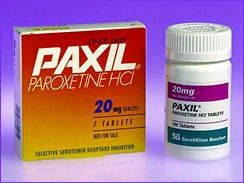As if we didn't know already (as if Glaxo didn't know all those years ago)
A new study carried out by the University of Utah has revealed what Glaxo have been hiding from the public for many years. The only people that really know the truth are the US Courts where information has been suppressed as part of settlement agreements made between Glaxo and Plaintiff lawyers.
In a nutshell, GSK attorneys come to a compromise when their case defending Paxil goes pear-shaped. They, of course, use all the tools at their disposal - the statute of limitations, whether or not a fetus is viable, ie, whether or not it can be regarded as a human at the time it was aborted - they also use many other points of law to defend their toxic blockbuster drug.
According to Neurotoxicology and Teratology, Volume 47, January–February 2015, mice exposed during development experienced a multitude of problems: males weighed less, had fewer offspring, dominated fewer territories and died at a higher rate. Females took longer to produce their first litters, had fewer pups and pups that were underweight.
The Paxil doses were relatively close to those prescribed for people.
In the study, researchers gave food laced with Paxil to 20 breeding pairs of mice for several weeks, until all had produced up to four litters. The offspring also ate Paxil-laced chow until they reached breeding age.
This from Newswise...
Researchers then released the exposed offspring into the competitive arena with the offspring of a control group of mice never exposed to Paxil. Groups consisted of eight males and 14 to 16 females, creating population densities comparable to those seen in the wild. The researchers started five such populations and kept them going for six months.
Males exposed to Paxil were about half as likely to control a territory. They also lagged behind control males in body weight throughout the weeks of competition and were more likely to die. Exposed males produced 44 percent fewer offspring. Exposed females showed no significant weight or mortality differences, but they produced half as many offspring as control females at the initial assessment. Their fecundity rebounded at later time points.
Are we surprised anymore?
Question is... Why has it taken so long for such a study to be carried out? In truth, it hasn't.
Here's a bit of history...
3-year-old Lyam Kilker was born with serious heart defects. While pregnant, Kilker's mother took the antidepressant paroxetine [Paxil]. The Jury's decision in this case was that Paxil was the causation of Lyam Kilker being born with heart defects. In other words, Paxil was deemed responsible as the agent that disturbed the development of an embryo or fetus.
The following was taken from the court transcript in the Kilker v GlaxoSmithKline trial. [Verbatim]
"In May of this year, 2009, a study was published by Doctor Sloot. The study said this.
"What Doctor Sloot did is, he took Paxil and all the other reuptake inhibitors and he exposed rat fetuses to these 12 different drugs, including Paxil. And what Shearing Plough was trying to figure out, what they were trying to do was figure out whether one of the drugs that they were going to put on the market to compete with GSK's drug was capable of causing birth defects. And so they took the drug they were going to take to market, and before they took it to market, they did this test. And they compared it to all the other SSRIs. Because, as you will learn, GSK never did this test.
"What Doctor Sloot discovered in May of this year is that out of all the teratogen, out of all the SSRIs, the 12, only one was a clear teratogen, Paxil. He discovered that Paxil in May of this year was actually more powerful a teratogen than cocaine.
"It would be safer, according to Doctor Sloot's study, to take cocaine than it would be to take Paxil while you were pregnant.
"Now, Shearing Plough, quite rightly, took their drug that they were thinking about taking to market to compete with Paxil, and even though it was just a possible teratogen, they scrapped their plans to take it to market and decided the risk was not worth the benefit."
Upon this revelation I emailed both Glaxo and the British drug regulator, the MHRA. All of that correspondence is featured in my book, The evidence, however, is clear, the Seroxat scandal. For those of you that don't have a copy there's an extract featuring that correspondence here.
No doubt medicine regulators around the globe will raise an eyebrow at the latest study by the University of Utah, they may shuffle uncomfortably... then ignore the findings. That's my experience of regulators. Quite why they are called regulators baffles me.
Paxil is just one example of a pill causing birth defects, there are many more, much of which are dished out to women because they have some form of dangerous depression during their pregnancy, a depression, that we are told, if left untreated can be passed on to the fetus.
Genius marketing folks...with the sole aim of making money...and lots of it.
Bob Fiddaman.
Related
Ryan, Glaxo's Non-Viable Fetus - Part I
Ryan, Glaxo's Non-Viable Fetus - Part II - The Twists






No comments: